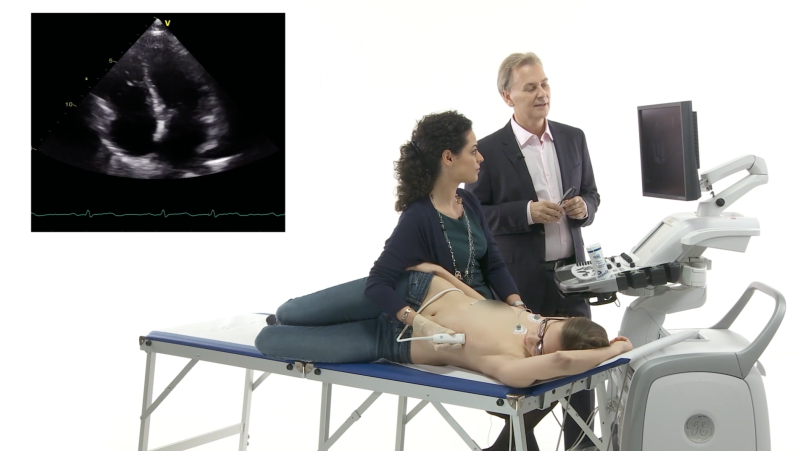Catching the Right Moment
I like photography. With a simple click you can capture a precious moment, create emotions, or tell a story. Take a look at the following photo and you'll see what I mean.

Why is this photo so captivating? Because the shutter of the camera was released exactly at the right time. It freezes the exact instance when the wings of the hummingbird are unfolded. It illustrates a brief and expressive moment that would be difficult to see or remain invisible to the human eye.
How does this apply to echo?
Take a look at the following echo of a patient with an enlarged right ventricle. Do you see the pathology?
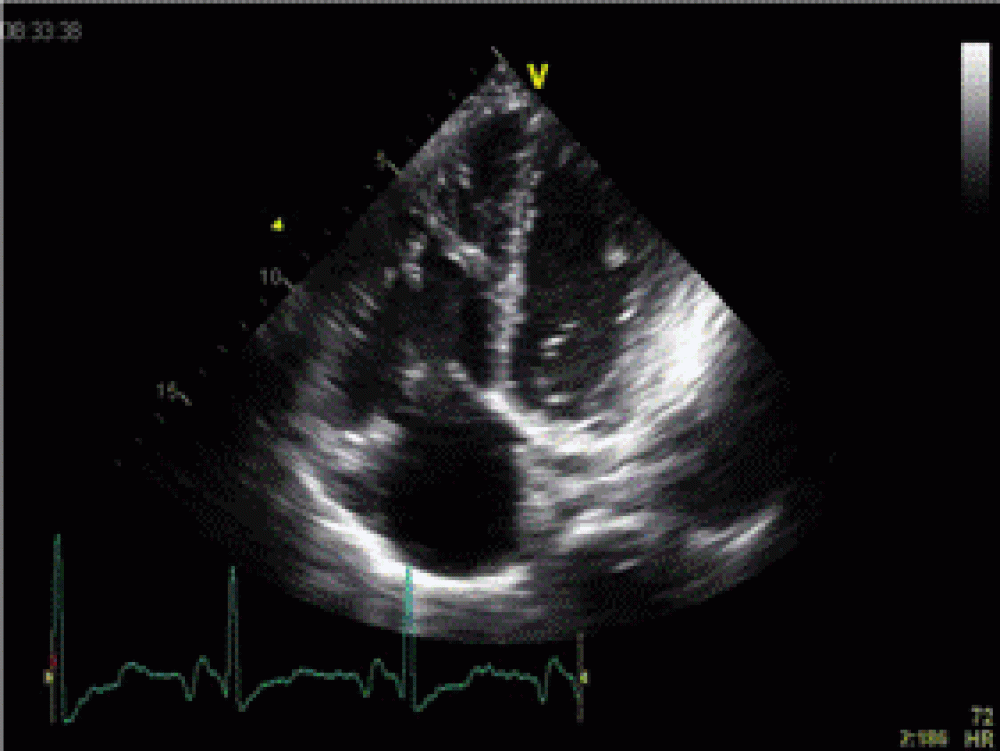 Four-chamber view of a patient with a large right ventricle.
Four-chamber view of a patient with a large right ventricle.
Focus on the tricuspid valve. Maybe you can detect it now on this magnified view?
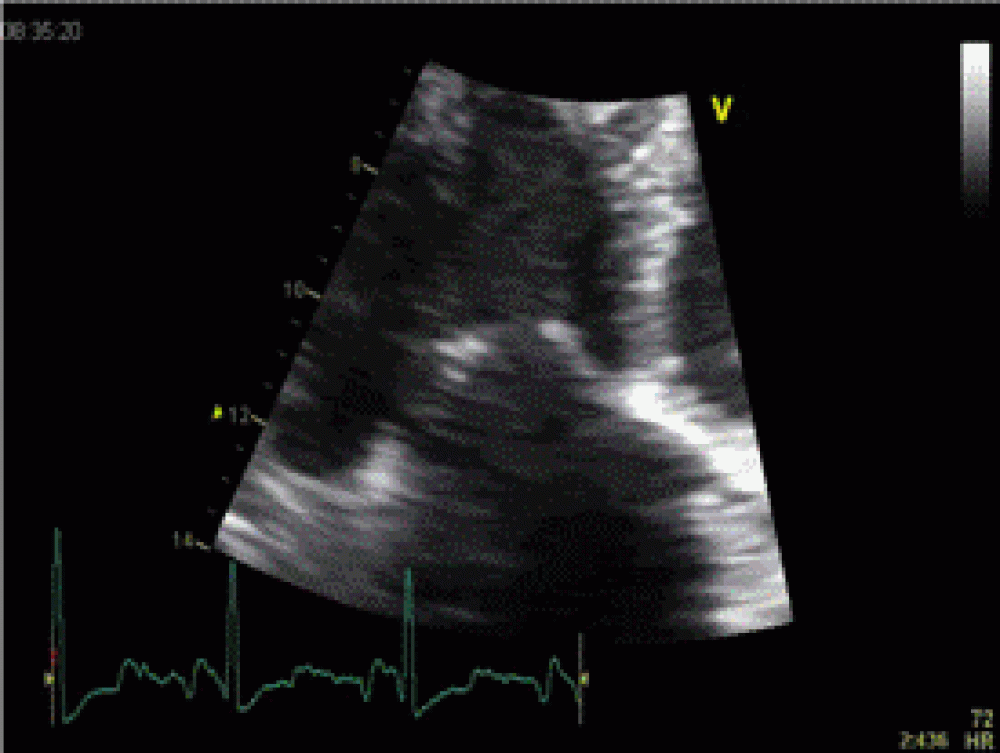 Zoom view of the tricuspid valve.
Zoom view of the tricuspid valve.
It's quite difficult to see. But if you use color Doppler, you'll find a clue that points in the right direction:
 Four-chamber view – color-Doppler of the same patient.
Four-chamber view – color-Doppler of the same patient.
I am not talking about the presence of tricuspid regurgitation - which is quite obvious - but the jet direction. It is rather eccentric and directed towards the interatrial septum. An eccentric jet is unusual in functional tricuspid regurgitation (i.e. annular dilatation). So you should look for a structural defect of the tricuspid valve. What you should pick up on the 2D view is the ruptured anterior leaflet. A tiny portion of the tricuspid valve protrudes into the right atrium and is flail. Indeed, a subtle abnormality – but with an important consequence (severe regurgitation).
Now apply what you just learned
Here is another example that calls for a "quick eye": this time a pathology that we found on a TEE study of a patient with mitral regurgitation.
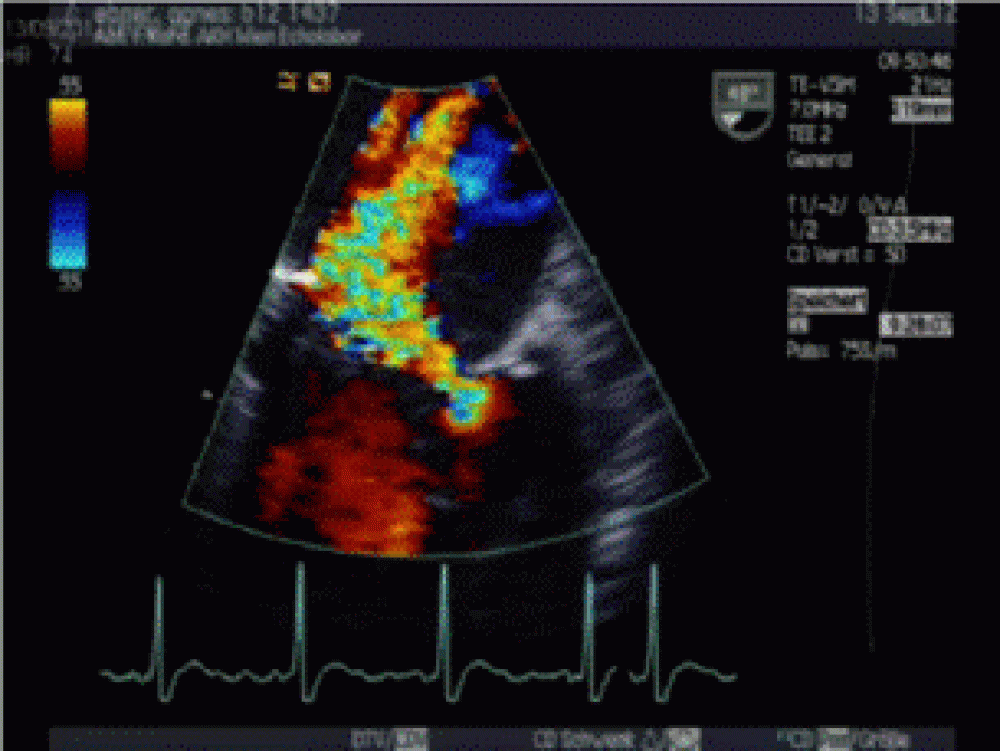 TEE study - color-Doppler study of a patient with mitral regurgitation.
TEE study - color-Doppler study of a patient with mitral regurgitation.
Again we see a very eccentric jet. As you now know what you should look for on the 2D view, it will be easier to make the diagnosis.
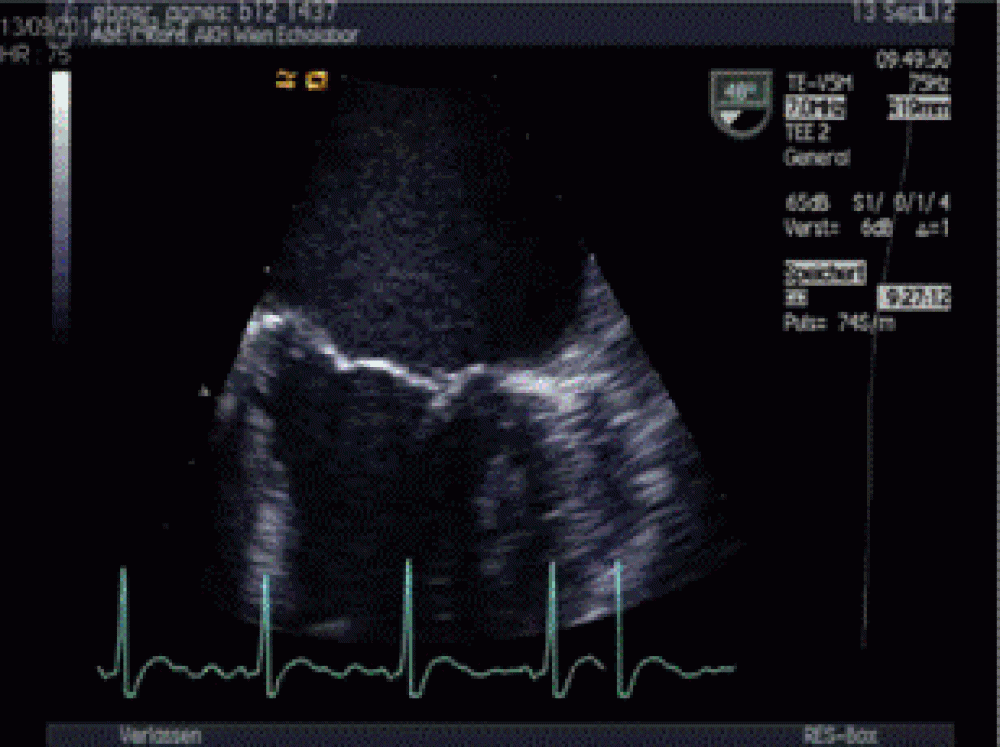 TEE study showing the mitral valve.
TEE study showing the mitral valve.
Again you need to “catch” exactly the right moment. The moment when the tiny ruptured portion of the posterior mitral valve leaflet is seen. What this example shows is a flail mitral valve leaflet. Note that the pathology is only seen on one frame. However, the principle of “catching the right moment” does not only apply to flail leaflets. There are many other situations in which the pathology can only be seen if you concentrate on a short phase of the cardiac cycle. Are you ready for some color-Doppler images?
Flow and time
The following image clip shows the echo of a patient with a DDD pacemaker who presented with dyspnea.
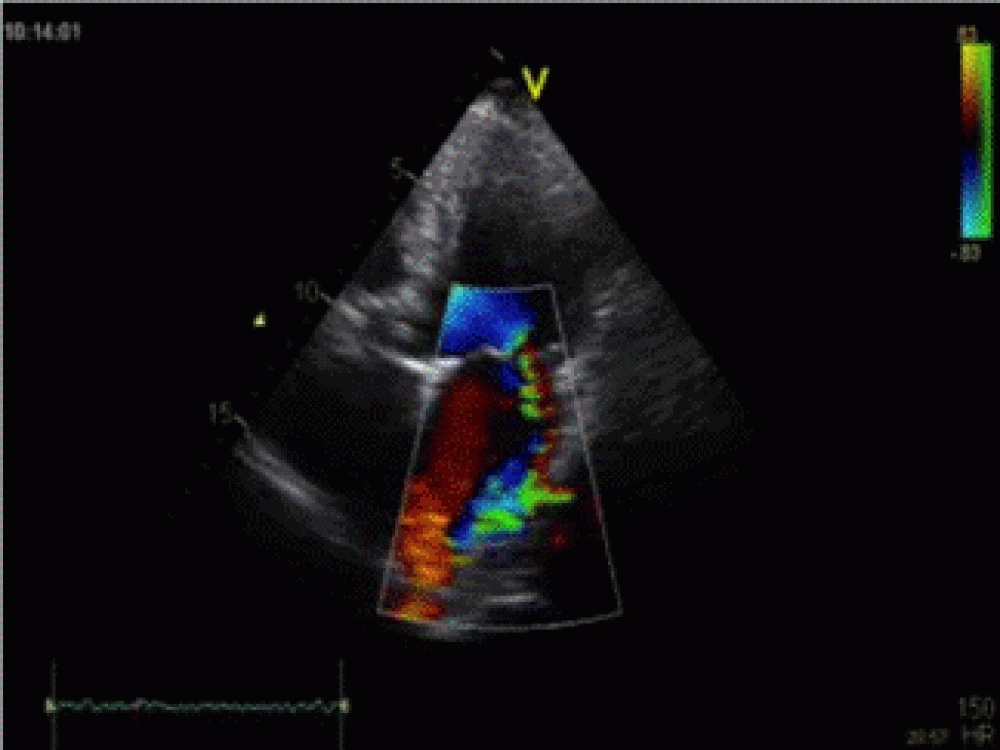 Four-chamber view – color-Doppler.
Four-chamber view – color-Doppler.
I am sure you can see mitral regurgitation in this patient. You will agree that it is at least moderate in terms of severity. But if you are able to observe the timing of events, you might notice an additional finding: the duration of regurgitation is very long. It starts very early. To get a better notion of the timing of events, here is the corresponding CW Doppler spectrum:
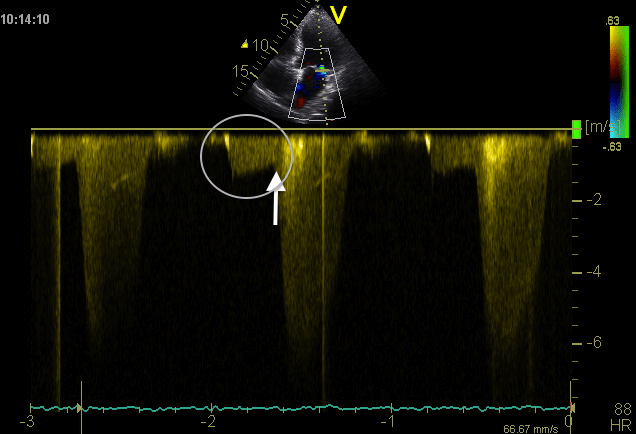 CW Doppler spectrum of mitral regurgitation. There is a component of MR (circle) before the onset of systole (arrow).
CW Doppler spectrum of mitral regurgitation. There is a component of MR (circle) before the onset of systole (arrow).
See what I mean? That is what we call “presystolic mitral regurgitation”. Sure, CW Doppler shows the timing of events and permits you to detect presystolic mitral regurgitation. But we don’t routinely perform CW Doppler of MR in all patients with MR. In this case “a rapid eye” made us curious and urged us to perform a CW Doppler study.
Are you ready for one last example?
The following study is from a patient who presented with a systolic murmur. How does timing of mitral regurgitation come in here?
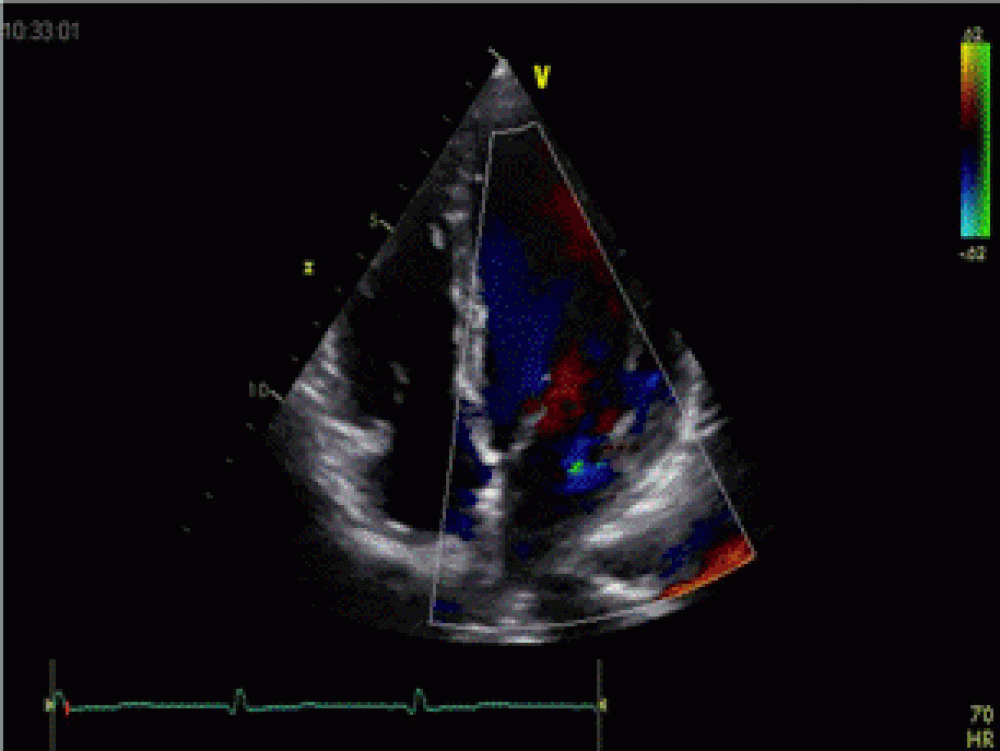 Four-chamber view (Color Doppler) of a patient with mitral valve prolaps.
Four-chamber view (Color Doppler) of a patient with mitral valve prolaps.
Compared to the previous patient we see something fundamentally different: regurgitation starts late in systole. The CW Doppler spectrum will again permit us to discern the exact timing of MR.
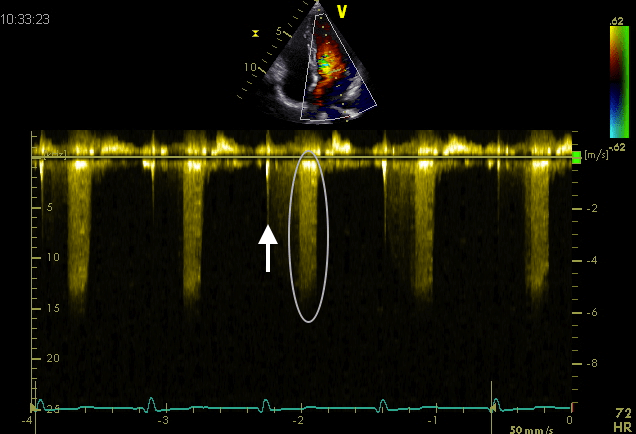 CW Doppler spectrum of MR. The main component of the jet (circle) starts late (mid systole) after the onset of systole (arrow).
CW Doppler spectrum of MR. The main component of the jet (circle) starts late (mid systole) after the onset of systole (arrow).
This feature is rather typical for patients with bileaflet mitral valve prolaps. The valve stays competent until mid-systole, when it really starts to protrude into the left atrium and the leaflets start to loose coaptation.
Does all this have an impact on clinical practice?
The answer clearly is YES. The first patient had right heart catheter previously and we suspected that the valve was damaged during the procedure (iatrogenic form of tricuspid regurgitation).In the second patient the surgeon will know what to look for when he tries to repair the valve. The third patient will benefit from “reprogramming” of his pacemaker by way of a shorter AV delay. Why? Because pre-systolic MR usually occurs in the setting of a long delay between atrial contraction and the onset of systole (i.e. first degree AV-block). Finally, in the last patient one could falsely misclassify mitral regurgitation as severe if the duration of MR is not taken into account. After all, the entire volume that is regurgitated is much less when MR is present for just a short period of time.
By the way, if you want to see another example of how important a “quick eye” is, take a look at one of our previous newsletters entitled “Fear of complexity". In this example you also need a quick eye to detect the septal bounce that ultimately leads to the diagnosis of constrictive pericarditis.
How to train your eye:
How do you develop the skill of a quick eye? Here is my suggestion: first, use the scroll function to review the images frame by frame or in slow motion. That is what they do on television to review special moments in sports events. Once you start to recognize the patterns you will be able to see the pathology in real time as well. Further useful tips that will improve your scanning skills can be found here. Also, check out our echo tips here.
But most important of all: use every opportunity to look at echocardiograms. Like most things in life, it is a mater of practice.
Our role at 123sonography is to give you opportunities to see many examples and draw your attention to those special moments that make a difference. If you want to take the next step and become an echo master, check out our Echo Masterclass. It's THE most effective program to take your echo skills to the next level!
Yours,
Tommy & the 123sonography team



